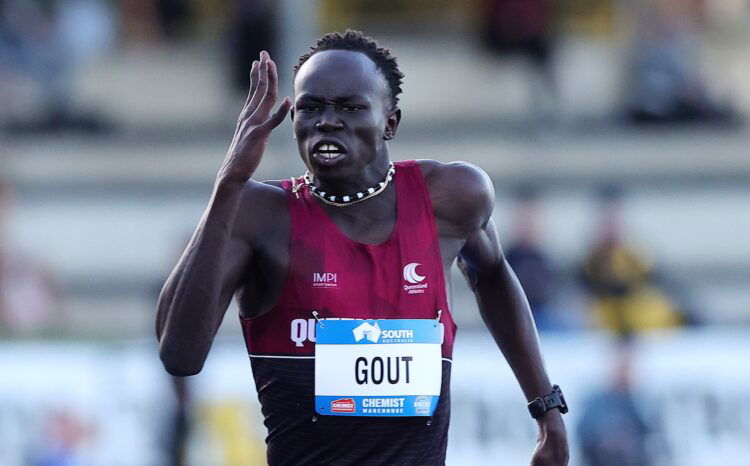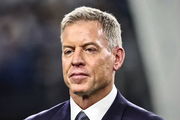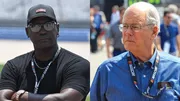
Getty
ADELAIDE, AUSTRALIA – APRIL 11: Gout Gout of Queensland winning the mens u20 100m during the 2024 2024 Australian Athletics Championships at SA Athletics Stadium on April 11, 2024 in Adelaide, Australia. (Photo by Sarah Reed/Getty Images)

Getty
ADELAIDE, AUSTRALIA – APRIL 11: Gout Gout of Queensland winning the mens u20 100m during the 2024 2024 Australian Athletics Championships at SA Athletics Stadium on April 11, 2024 in Adelaide, Australia. (Photo by Sarah Reed/Getty Images)
The history of sprinting is often told through veterans who carry reputations built over years. Yet in 2025, the storyline is shifting. The fastest times of the season are no longer reserved for the most decorated names in track & field but are increasingly emerging from athletes barely out of school. In different corners of the globe, national federations are turning to teenagers to anchor their squads at the senior World Athletics Championships.
Watch What’s Trending Now!
The phenomenon is not accidental. Coaches and selectors have measured how raw speed and composure under pressure have pushed certain young runners close to established professionals. What once looked like the distant future now appears on the entry lists for Tokyo. The sight of fresh faces on sprinting’s biggest stage signals a deliberate gamble, one that suggests confidence in a younger generation’s ability to deliver at the highest level.
South Africa, Australia, the United States, Nigeria, and Japan have all named teenagers to their senior rosters. Bayanda Walaza, Gout Gout, Maurice Gleaton, Israel Okon, and Shimizu Sorato represent contrasting backgrounds but share a common trait. Their times in 2025 match, and in some cases surpass, experienced campaigners.
ADVERTISEMENT
Now, as the Worlds are set to commence between September 13 and 21, 2025, with over 2k athletes participating from around 200 countries, the limelight might be more on these teenage sensations.
Bayanda Walaza: South Africa’s rising track & field anchor
South Africa’s Bayanda Walaza enters Tokyo with Team South Africa’s 49-athlete roster backed by a season defined by consistency and medals. At the FISU World University Games in Bochum, he captured gold in both the 100m and 200m, clocking 10.16s and 20.63s, before adding a relay silver. He later dipped under ten seconds at the AGN Track and Field Championships (9.99s) and improved further to 9.94s at the Boris Hanzekovic Memorial.
ADVERTISEMENT
Walaza has spoken with unusual clarity about his aims. “It (his goals) is showing up in the world stage, and showing people that South Africa can produce other sprinters [other than Akani Simbine],” he explained. He has emphasized that reaching the final and medaling are realistic objectives, while long-term targets center on the Los Angeles 2028 Olympics.
Despite a minor injury scare at the Zurich Diamond League, South African officials retained him in the squad. His presence in the relay is especially valued, given his Olympic silver medal from Paris and the country’s tradition of producing sharp baton squads. Walaza himself framed his competitive spirit plainly, “I want to be a threat (at the world championships). I don’t want to be someone they take lightly. When I step onto that track, they must know this boy is here to put up a show.”
ADVERTISEMENT
Gout Gout: Australia’s 200m phenomenon
At 17, Gout Gout has altered the trajectory of Australian sprinting. His 20.02s at the Golden Spike Ostrava broke the national and Oceanian records, while a wind-assisted 19.84s at the national championships suggested his ceiling is higher still. As he gears up for the 200m race at Tokyo, media comparisons with Usain Bolt have become inevitable. It got reinforced by the coincidence of Bolt’s own 200m breakthrough at the same Czech meet two decades earlier.
Top Stories
Forced to Leave FOX, Cowboys Legend Troy Aikman Says ESPN Is Like ‘U.S. Government’ & Clearly Distinguishes the Two Networks

Who Is Paige Shiver? All About Michigan Football Staffer & Daughter of Veteran Bears Scout Jeff Shiver

FOX Issues Strict Ban on Terry Bradshaw But NFL Legend Defies It to Join Popular Morning Show

Michael Jordan Brings NASCAR to Its Knees as Jim France’s Courtroom Collapse Triggers Settlement

What Happened to T.J. Watt? Why Is He Hospitalized? Steelers Announce Latest News on LB Before Dolphins Game

LIV Golf to Cut Ties With Veteran Pro After His PGA Tour Return Intentions Became Public

Asked about the parallels, Gout Gout replied carefully, “Who doesn’t want to be Usain Bolt? Being compared to Usain Bolt feels great but I would like to put my personality in the upcoming story.” The teenager prefers the 200m, citing the distance as giving him space to build rhythm.
ADVERTISEMENT
Australia’s choice to bring him into the senior program reflects urgency. He is the youngest national record holder in the country’s sprinting history and has already faced international opposition in Monaco and Ostrava. His statement of intent was clear: “The main goal of the season is obviously world championships. Let’s see what I can do on the world stage against professional athletes. Hopefully I can run fast and perform well.”
Maurice Gleaton: America’s high school record breaker
In the United States, the sprinting depth is enormous, yet Maurice Gleaton has broken through by setting a Georgia state record of 9.98s at just 17. That mark pushed him ahead of Christian Coleman’s high school performances, placing him in a lineage that has historically led to global medals. And then, his 9.92s North American U20 Record at just 18, finishing 6th at the USATF, earned him a place on Team USA’s 4x100m relay pool.
ADVERTISEMENT
Known as “Lae” in the track & field community, Gleaton is set to join the University of Georgia program next year but already treats world-level competition as an achievable step. His ability to break ten seconds before graduation is the benchmark that has convinced selectors he is not merely a developmental prospect.
With Coleman and Noah Lyles anchoring senior squads, Gleaton’s role is not to displace them but to establish his name early. His ambition extends to Olympic competition, and his World Championships appearance provides a practical rehearsal. In a program known for its relentless turnover of talent, Gleaton is the youngest yet to claim sub-10 authority at the state level.
ADVERTISEMENT
Israel Okon: Nigeria’s next in line for track & field
Israel Okon is all set to rewrite Nigeria’s sprinting charts with his 100m participation as the Athletics Federation of Nigeria announces their 15-athlete roster for the Worlds. At Auburn University, he equaled the school record in the 60m with 6.51s, tying legends Davidson Ezinwa and Favour Ashe. Outdoors, he ran a 9.91s 100m this year, placing him among the fastest U20 sprinters globally. At Lucerne, he improved his legal best to 10.06s, the fastest overall performance of the evening.
Okon combines individual promise with relay credentials. He delivered gold for Nigeria in the 4x100m at the 2023 African Games, and his selection for Tokyo underscores the nation’s confidence in its younger pool. His progression has been steady, from African junior titles to NCAA finals and now to a senior world championship.
At only 19, his consistency across the 60m, 100m, and 200m disciplines makes him versatile, but the 100m remains his primary event. Nigeria has long sought to produce another global sprinting star in the tradition of Olusoji Fasuba. And Okon is viewed as the most credible candidate of the past decade.
ADVERTISEMENT
Shimizu Sorato: Japan’s bold track & field inclusion
Japan’s relay culture has always favored precision and reliability. The inclusion of Shimizu Sorato in their 51-man roster, however, represents a calculated risk. At just 16, he ran 10.00s at a high school meet in July, establishing an under-18 world best. His time secured him a spot in Japan’s 4x100m relay pool for the Tokyo championships.
Team officials are candid about both his rawness and potential. “He ran a 10.00 as a high schooler,” delegation head Yamazaki Kazuhiko stated. “It’s very difficult for him to run at the senior level on a regular basis given the rules but we are counting on his unknown quantity which allowed him to run a 10.00.”
ADVERTISEMENT
The Japanese federation hopes his early exposure will mirror the development path of past prodigies who matured into consistent relay anchors. For Shimizu, the challenge will be to adapt quickly to the professional circuit’s pace. Yet his record-setting run indicates that the country sees him not just as an experiment but as a long-term relay investment.
Together, these athletes reflect a pattern visible across continents. Federations are no longer waiting for athletes to reach their mid-20s before placing them on the biggest stage. The sub-10 barrier, once reserved for seasoned professionals, has been breached by high school and university runners. National selectors now treat teenage performances as evidence of immediate readiness rather than distant promise.
The Tokyo championships will reveal how much of this early trust translates into results. For Walaza, Gout, Gleaton, Okon, and Shimizu, the challenge is to prove that world-class sprinting careers can begin before adulthood. Their emergence signals both the depth of modern talent and the growing willingness of nations to test the youngest in the fiercest arena.
ADVERTISEMENT
ADVERTISEMENT
ADVERTISEMENT

